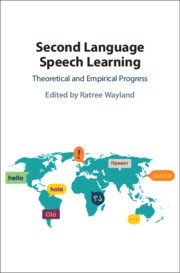Book contents
- Second Language Speech Learning
- Second Language Speech Learning
- Copyright page
- Dedication
- Contents
- Figures
- Tables
- Contributors
- Preface
- Acknowledgments
- Part I Theoretical Progress
- Part II Segmental Acquisition
- Chapter 6 English Obstruent Perception by Native Mandarin, Korean, and English Speakers
- Chapter 7 Changes in the First Year of Immersion
- Chapter 8 Effects of the Postvocalic Nasal on the Perception of American English Vowels by Native Speakers of American English and Japanese
- Part III Acquiring Suprasegmental Features
- Part IV Accentedness and Acoustic Features
- Part V Cognitive and Psychological Variables
- Index
- References
Chapter 7 - Changes in the First Year of Immersion
An Acoustic Analysis of /s/ Produced by Japanese Adults and Children
from Part II - Segmental Acquisition
Published online by Cambridge University Press: 21 January 2021
- Second Language Speech Learning
- Second Language Speech Learning
- Copyright page
- Dedication
- Contents
- Figures
- Tables
- Contributors
- Preface
- Acknowledgments
- Part I Theoretical Progress
- Part II Segmental Acquisition
- Chapter 6 English Obstruent Perception by Native Mandarin, Korean, and English Speakers
- Chapter 7 Changes in the First Year of Immersion
- Chapter 8 Effects of the Postvocalic Nasal on the Perception of American English Vowels by Native Speakers of American English and Japanese
- Part III Acquiring Suprasegmental Features
- Part IV Accentedness and Acoustic Features
- Part V Cognitive and Psychological Variables
- Index
- References
Summary
This chapter reports preliminary results of an acoustic analysis of fricatives in American English produced by native Japanese-speaking adults and children. The data were from 16 native Japanese (NJ) adults and 16 NJ children as well as 16 native English-speaking (NE) adults and NE children. All 64 participants were tested twice, one year apart to study NJ adults’ and children’s learning of English. Their production of /s/ in the word ‘six’ was acoustically analyzed. Noise duration (absolute and normalized), fricative intensity, and center of gravity (CoG) were measured. For duration, the NJ adults’ /s/ was longer than the NE adults’ /s/ in both absolute duration and normalized duration. The CoG values were greater in the NE adults’ and children’s /s/ than in the NJ adults’ and children’s /s/. Noise amplitude was greater in the NE speakers’ /s/ than in the NJ speakers’ /s/. These results suggest that the NJ speakers’ /s/ was slightly more back than the NE speakers’ /s/ productions and that the NE speakers’ /s/ was more sibilant than the NJ speakers’ /s/. In addition, the noise amplitude increased significantly over the course of one year in the NJ children’s productions.
- Type
- Chapter
- Information
- Second Language Speech LearningTheoretical and Empirical Progress, pp. 213 - 227Publisher: Cambridge University PressPrint publication year: 2021



